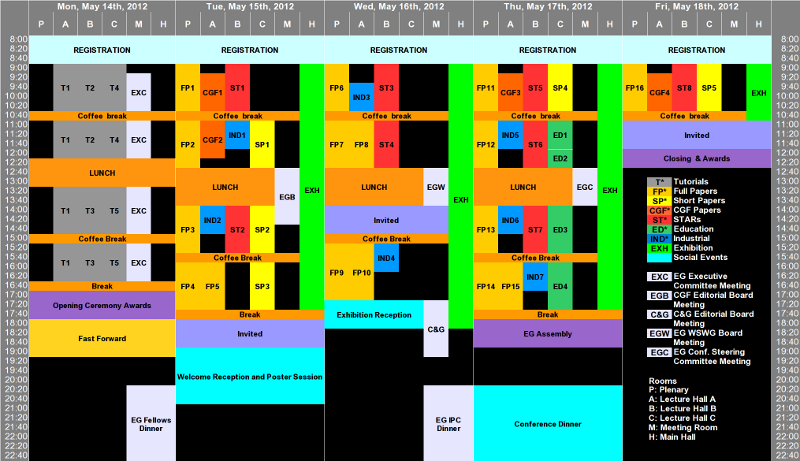Tutorials Track
T1: Mapping images to target devices: spatial, temporal, stereo, tone, and color
Monday, May 14th, 9:00-16:40 (Full Day) in Room A
Presenters: F. Banterle (ISTI-CNR), A. Artusi (Cyprus Institute), T. O. Aydin (Disney Research Zurich), P. Didyk (MPI Informatik), E. Eisemann (Telecom Paris Tech), D. Gutierrez (University of Zaragoza), R. Mantiuk (Bangor University), K. Myszkowski (MPI Informatik), T. Ritschel (MPI Informatik)
Abstract. Retargeting is a process through which an image or a video is adapted from the display device for which it was meant (target display) to another one (retarget display). The retarget display can have different features from the target one such as: dynamic range, discretization levels, color gamut, multi-view (3D), refresh rate, spatial resolution, etc. This tutorial presents the latest solutions and techniques for retargeting images along various dimensions (such as dynamic range, colors, temporal and spatial resolutions) and offers for the first time a much-needed holistic view of the field. This includes how to measure and analyze the changes applied to an image/video in terms of quality using both (subjective) psychophysical experiments and (objective) computational metrics.
T2: Diffusion Geometry in Shape Analysis
Monday, May 14th, 9:00-12:20 (Half Day) in Room B
Presenters: M. Bronstein (USI), U. Castellani (University of Verona), A. Bronstein (Technion)
Abstract. Over the last decade, the intersections between 3D shape analysis and image processing have become a topic of increasing interest in the computer graphics community. Nevertheless, when attempting to apply current image analysis methods to 3D shapes (feature-based description, registration, recognition, indexing, etc.) one has to face fundamental differences between images and geometric objects. Shape analysis poses new challenges that are non-existent in image analysis. The purpose of this tutorial is to overview the foundations of shape analysis and to formulate state-of-the-art theoretical and computational methods for shape description based on their intrinsic geometric properties. The emerging field of diffusion geometry provides a generic framework for many methods in the analysis of geometric shapes and objects. The tutorial will present in a new light the problems of shape analysis based on diffusion geometric constructions such as manifold embeddings using the Laplace-Beltrami and heat operator, heat kernel local descriptors, diffusion and commute-time metrics.
T3: Dynamic Geometry Processing
Monday, May 14th, 13:20-16:40 (Half Day) in Room B
Presenters: W. Chang (UCSD), H. Li (Columbia University), N. Mitra (UCL), M. Pauly (EPFL), M. Wand (MPI Informatik)
Abstract. Throughout the last few years, acquisition and processing of dynamic geometry has already received quite an amount of attention in the computer vision and graphics research community. Recently, the topic has gained a significant boost due to the availability of commodity devices for dynamic geometry acquisition: The introduction of the Microsoft “Kinect” device made this kind of technology broadly available, being very well received by both researchers and end-users, and even more development in this direction can probably be expected for the near future. The tutorial on “Dynamic Geometry Processing” considers the problem of processing such dynamic range data effectively and efficiently. The tutorial introduces basic processing techniques for analyzing and matching range data. It introduces models for correspondence estimation and presents the according basic algorithmic building blocks. Furthermore, it discusses the current state-of-the-art by looking at example approaches for processing and real-time tracking of dynamic data. In addition, the tutorial will also identify and discuss future challenges in the field, aiming at inspiring future work in this exciting area of research.
T4: Polygon Mesh Repairing: An Application Perspective
Monday, May 14th, 9:00-12:20 (Half Day) in Room C
Presenters: M. Campen (RWTH Aachen), M. Attene (IMATI-CNR), L. Kobbelt (RWTH Aachen)
Abstract. Digital 3D models are key components in many industrial and scientific sectors. In numerous domains polygon meshes have become a de facto standard for model representation. In practice meshes often have a number of defects and flaws that make them incompatible with quality requirements of specific applications. Hence, repairing such defects in order to achieve compatibility is a highly important task – in academic as well as industrial applications. In this tutorial we first systematically analyze typical application contexts together with their requirements and issues, as well as the various types of defects that typically play a role. Subsequently, we consider existing techniques to process, repair, and improve the structure, geometry, and topology of imperfect meshes, aiming at making them appropriate to case-by-case requirements. We present seminal works and key algorithms, discuss extensions and improvements, and analyze the respective advantages and disadvantages depending on the application context. Furthermore, we outline directions where further research is particularly important or promising.
T5: Recent Advances in Real-Time Collision and Proximity Computations for Games and Simulations
Monday, May 14th, 13:20-16:40 (Half Day) in Room C
Presenters: S. Frye (EA), T. Harada (AMD), Y. J. Kim (EWHA University), S.-e. Yoon (KAIST)
Abstract. Our objective is to introduce and teach students and practitioners about efficient proximity computation methods and their practical implementations. By doing so, we can expose the attendees to the latest developments, to bridge the gap between the two different fields: proximity computation and simulation. At a broad level, this course will cover the following topics:
-
Basic algorithms for various proximity queries including collision detection, minimum separation distances, penetration depth, etc.
-
Discrete and continuous algorithms for rigid, articulated, deforming, and fracturing models.
-
Parallel algorithms that utilize many cores of CPUs, GPUs, or CPUs/GPUs.
-
Optimized proximity data structures for many-core architectures including GPU
-
Integrating proximity computation algorithms into physically-based simulation systems.
World-class expert instructors, both from academia and industry, have significant experiences in designing and implementing different aspects of the aforementioned teaching materials.





